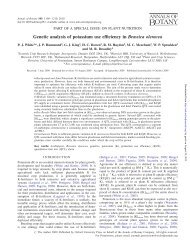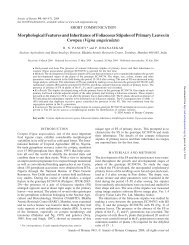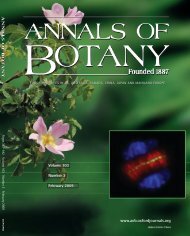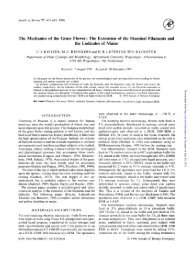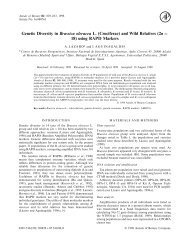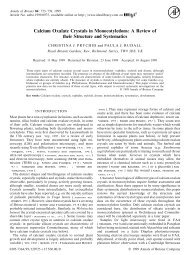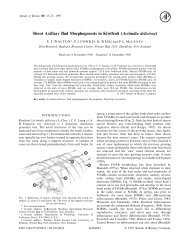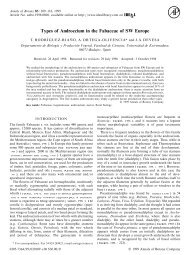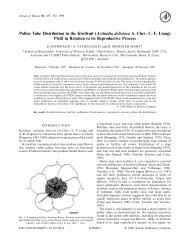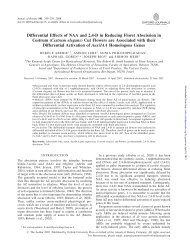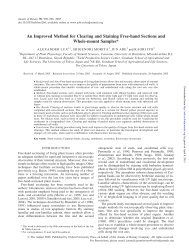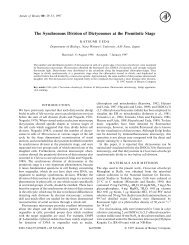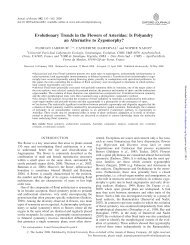Floral Structure of Kirkia (Kirkiaceae) and its ... - Annals of Botany
Floral Structure of Kirkia (Kirkiaceae) and its ... - Annals of Botany
Floral Structure of Kirkia (Kirkiaceae) and its ... - Annals of Botany
Create successful ePaper yourself
Turn your PDF publications into a flip-book with our unique Google optimized e-Paper software.
548<br />
Bachelier <strong>and</strong> Endress — Flowers <strong>of</strong> <strong>Kirkia</strong> <strong>and</strong> Position in Sapindales<br />
This protrusion is commonly hidden in taxa with postgenitally<br />
united stigmas/styles (e.g. Beiselia, Burseraceae;<br />
Dracontomelon, Anacardiaceae; Rutaceae, Simaroubaceae;<br />
J. B. Bachelier <strong>and</strong> P. K. Endress, unpubl. res.). It is,<br />
however, exposed in gynoecia without intercarpellary postgenital<br />
union (e.g. Pleiogynum, Spondias p.p., Poupartiopsis,<br />
Spondioideae; Mitchell et al., 2006; J. B. Bachelier <strong>and</strong><br />
P. K. Endress, unpubl. res.). On architectural grounds the<br />
dome is especially large in gynoecia with an increased<br />
number <strong>of</strong> carpels (Endress, 2006). Interestingly, a symplicate<br />
zone is lacking in <strong>Kirkia</strong>ceae <strong>and</strong> in Spondioideae<br />
(Anacardiaceae), or very short in Beiselia (Burseraceae). In<br />
contrast, in core Burseraceae, a symplicate zone is present<br />
<strong>and</strong> extends from the synascidiate base <strong>of</strong> the gynoecium to<br />
the base <strong>of</strong> the stigmatic head (J. B. Bachelier <strong>and</strong><br />
P. K. Endress, unpubl. res.).<br />
Ovules<br />
The crassinucellar, bitegmic ovules in <strong>Kirkia</strong> are antitropous<br />
(epitropous) as are those <strong>of</strong> Burseraceae (<strong>and</strong> also<br />
Rutaceae, Simaroubaceae <strong>and</strong> Meliaceae), while those <strong>of</strong><br />
Anacardiaceae (<strong>and</strong> also Sapindaceae) are syntropous (apotropous).<br />
They are slightly campylotropous (especially<br />
involving the basal area <strong>of</strong> the nucellus), a trait also shared<br />
with other Sapindales, especially Burseraceae (Wiger,<br />
1935; Narayana, 1959b, 1960a, b; J. B. Bachelier <strong>and</strong><br />
P. K. Endress, unpubl. res.), Simaroubaceae (Wiger, 1935;<br />
Narayana, 1957), Rutaceae (Mauritzon, 1935; Boesewinkel,<br />
1977, 1984; Souza et al., 2003), <strong>and</strong> Sapindaceae (e.g.<br />
Weckerle <strong>and</strong> Rutishauser, 2003, 2005). In contrast,<br />
Anacardiaceae tend to have anatropous ovules (Bachelier<br />
<strong>and</strong> Endress, 2007; J. B. Bachelier <strong>and</strong> P. K. Endress,<br />
unpubl. res.). The inner integument is thicker than the outer<br />
in <strong>Kirkia</strong>, another tendency shared by many Sapindales <strong>and</strong><br />
other malvids (Endress <strong>and</strong> Matthews, 2006).<br />
A peculiarity <strong>of</strong> the ovules <strong>of</strong> <strong>Kirkia</strong> is that they have an<br />
exceedingly long micropyle formed by elongation <strong>of</strong> both<br />
integuments. Conspicuous is the cell enlargement <strong>of</strong> the<br />
outer integument accompanying the elongation. These features<br />
were not observed in Anacardiaceae <strong>and</strong> Burseraceae<br />
<strong>and</strong> have not been reported from other Sapindales, <strong>and</strong><br />
may thus be autapomorphies for <strong>Kirkia</strong>. The micropylar<br />
part <strong>of</strong> the outer integument is conspicuously wavy. Such<br />
wavy micropyles (but in the inner integument, with the<br />
outer not involved in micropyle formation) were illustrated<br />
for some other Sapindales as well (Burseraceae; Narayana,<br />
1959b, J. B. Bachelier <strong>and</strong> P. K. Endress, unpubl. res.;<br />
Simaroubaceae; Narayana, 1957; Nair <strong>and</strong> Sukumaran, 1960).<br />
Systematic aspects<br />
Do features <strong>of</strong> floral structure support the removal <strong>of</strong><br />
<strong>Kirkia</strong> from Simaroubaceae <strong>and</strong> a close relationship with<br />
the Anacardiaceae–Burseraceae clade, as is suggested by<br />
molecular phylogenetic studies (Muellner et al., 2007)?<br />
As seen from the comparative morphological studies on<br />
<strong>Kirkia</strong>ceae (this study) <strong>and</strong> Anacardiaceae <strong>and</strong> Burseraceae<br />
(J. B. Bachelier <strong>and</strong> P. K. Endress, unpubl. res.) <strong>and</strong> from<br />
comparison with published work on Sapindales, there is<br />
indeed a suite <strong>of</strong> features that appears to be synapomorphic<br />
for <strong>Kirkia</strong>ceae <strong>and</strong> Anacardiaceae plus Burseraceae. The<br />
pronounced convex remnant <strong>of</strong> the floral apex on top <strong>of</strong><br />
the syncarpous <strong>and</strong> entirely synascidiate ovary, <strong>and</strong> the<br />
almost complete absence <strong>of</strong> a symplicate zone in the gynoecium,<br />
as in Beiselia (Burseraceae) <strong>and</strong> Spondioideae<br />
(Anacardiaceae), appear to be unique for this clade, as<br />
they are not known from any other family <strong>of</strong> Sapindales<br />
(not recorded in Simaroubaceae: Engler, 1931c; Nair <strong>and</strong><br />
Joseph, 1957; Nair <strong>and</strong> Joshi, 1958; Narayana <strong>and</strong><br />
Sayeeduddin, 1958; Ramp, 1988; Meliaceae: Garudamma,<br />
1957; Narayana, 1958a; Nair, 1962, 1963; Murty <strong>and</strong><br />
Gupta, 1978a, b; Lal, 1994; Rutaceae: Gut, 1966; Ramp,<br />
1988; Sapindaceae: Weckerle <strong>and</strong> Rutishauser, 2003, 2005;<br />
Nitrariaceae: Nair <strong>and</strong> Nathawat, 1958; Ronse De Craene<br />
et al., 1996; Biebersteiniaceae: floral structure unstudied).<br />
This suite <strong>of</strong> characters is <strong>of</strong>ten associated with an increased<br />
number <strong>of</strong> carpels in a whorl (e.g. more than five in otherwise<br />
pentamerous flowers). However, it is also present in<br />
<strong>Kirkia</strong> with only four carpels <strong>and</strong> some Spondioideae with<br />
only three to five carpels. Thus the unique architecture <strong>of</strong><br />
the gynoecium is not necessarily dependent on an increase<br />
in carpel number.<br />
A number <strong>of</strong> other features <strong>of</strong> <strong>Kirkia</strong>ceae occur widely in<br />
Sapindales <strong>and</strong> are thus probably plesiomorphic for the<br />
clade <strong>of</strong> <strong>Kirkia</strong>ceae <strong>and</strong> Anacardiaceae plus Burseraceae:<br />
anthers with pseudopit, campylotropous ovules, antitropous<br />
curvature <strong>of</strong> ovules, inner integument thicker than outer<br />
(Endress <strong>and</strong> Stumpf, 1991; Endress <strong>and</strong> Matthews,<br />
2006), <strong>and</strong> the tendency to form gynoecia with an increased<br />
number <strong>of</strong> carpels (lacking in Simaroubaceae but also<br />
present in Rutaceae <strong>and</strong> Meliaceae). These features are<br />
probably synapomorphic at the level <strong>of</strong> Sapindales or<br />
even malvids (see Endress <strong>and</strong> Matthews, 2006).<br />
CONCLUSIONS<br />
The present comparative study <strong>of</strong> floral structure is the first in<br />
the family <strong>Kirkia</strong>ceae. It also provides the first structural comparison<br />
<strong>of</strong> <strong>Kirkia</strong>ceae with the Anacardiaceae–Burseraceae<br />
clade within Sapindales. Both the sister relationship <strong>of</strong><br />
<strong>Kirkia</strong>ceae <strong>and</strong> the Anacardiaceae–Burseraceae clade <strong>and</strong> a<br />
more distant relationship with Simaroubaceae, as found in<br />
molecular phylogenetic studies, are supported by floral structural<br />
features. The unusual two radially disposed locules per<br />
carpel in the former genus Pleiokirkia can be explained<br />
developmentally by the two <strong>of</strong>fset lateral placentae. The<br />
results are a step to a better underst<strong>and</strong>ing <strong>of</strong> the floral evolution<br />
in Sapindales.<br />
ACKNOWLEDGEMENTS<br />
We thank Eduard Ramp for kindly providing fixed material<br />
<strong>of</strong> <strong>Kirkia</strong> wilmsii <strong>and</strong> microtome sections, which were used<br />
in addition to our own section series. We acknowledge the<br />
Brunei Forestry Department <strong>and</strong> Brunei Herbarium for<br />
support in the collection <strong>of</strong> material <strong>of</strong> Anacardiaceae <strong>and</strong><br />
Burseraceae. We also thank J<strong>of</strong>fre Haji Ali Ahmad for organizing<br />
the collection trips <strong>and</strong> Jangarun Eri for his expertise<br />
in the field. The Georges-und-Antoine-Claraz-Schenkung is




